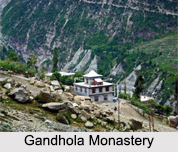 The Gandhola Monastery founded in the 8th century by Padmasambhava, also known as Guru Rinpoche, is located about eighteen kilometres from Keylong in Lahaul and Spiti district of Himachal Pradesh on the road from Manali. It is situated on a hilltop in Tupchiling village above the confluence of the rivers Chandra and Bhaga, which together forms the Chandrabhaga or the Chenab River. The monastery is now connected with the Drukpa Kargyu sect of Tibetan Buddhism, but its history long precedes the formation of that sect.
The Gandhola Monastery founded in the 8th century by Padmasambhava, also known as Guru Rinpoche, is located about eighteen kilometres from Keylong in Lahaul and Spiti district of Himachal Pradesh on the road from Manali. It is situated on a hilltop in Tupchiling village above the confluence of the rivers Chandra and Bhaga, which together forms the Chandrabhaga or the Chenab River. The monastery is now connected with the Drukpa Kargyu sect of Tibetan Buddhism, but its history long precedes the formation of that sect.
Architecture of Gandhola Monastery
The Gandhola Monastery or the Guru Ganthal Gompa is more than 800 years old and what sets it apart from all the other gompas are its wooden idols instead of the usual clay ones. The gompa comprises of distinct sculptures of Guru Padmasambhava, Brijeswari Devi and other lamas. There are myriad paintings, murals and a black-stone sculpture of the Goddess Kali. A damaged white marble head of Avalokitesvara is found here which was installed by the founder of the monastery. Avalokitesvara also known as Padmapani is a bodhisattva who embodies the compassions of all Buddhas. Portrayed in different cultures as either male or female, Avalokitesvara is one of the more widely revered bodhisattvas in mainstream Mahayana Buddhism, as well as unofficially in Theravada Buddhism. The image of Avalokitesvara is kept in the monastery itself, and is claimed to date back to the time of Nagarjuna in the 2nd century AD. In the year 1857, historian Mary Hay discovered a copper goblet which is stated to be an oldest example of excellent craftsmanship of metalwork by the Buddhists from the 1st century. This is known as the Kulu Vase, which is now placed in the British Museum.
The Gandhola Monastery is considered to have been part of a larger complex of structures; the present structure is two-storied instead of the seven-storied grandeur of alternating layers of stone and timber, which was once the seat of the local king. Gandhola Monastery seems to be the only monastery in the region other than Sani Monastery in Zanskar which has a history which is claimed to go back to Kushana times. The Gandhola Monastery underwent extensive repairs and a small pagoda roof of Kangra slates was added in 1959.
The Gandhola Monastery is an architectural masterpiece. The peculiar works of art gives it a unique factor which thus attracts tourists from around the world. The Tupchiling village is a 4 kilometres walk from the hilltop monastery. The monastery houses some very precious religious treasures with amazing architectural specimen.



















